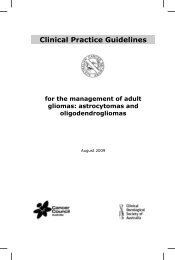Clinical Practice Guidelines for the management of locally advanced ...
Clinical Practice Guidelines for the management of locally advanced ...
Clinical Practice Guidelines for the management of locally advanced ...
You also want an ePaper? Increase the reach of your titles
YUMPU automatically turns print PDFs into web optimized ePapers that Google loves.
4 BIOCHEMICAL RELAPSE<br />
A significant clinical problem both in terms <strong>of</strong> frequency and lack <strong>of</strong> data to provide guidance is <strong>the</strong><br />
clinical scenario <strong>of</strong> patients with rising PSA levels and normal testosterone levels following definitive<br />
radio<strong>the</strong>rapy or radical prostatectomy.<br />
If <strong>the</strong> PSA rises following definitive local <strong>the</strong>rapy (radical prostatectomy or radiation <strong>the</strong>rapy), this<br />
is ei<strong>the</strong>r due to residual prostatic cancer in <strong>the</strong> prostatic bed and/or pelvic or distant metastases.<br />
Very rarely it may be due to residual benign prostatic tissue.<br />
It also should be realised that after radiation <strong>the</strong>rapy <strong>the</strong>re may be an initial PSA rise (‘PSA<br />
bounce’) 1, 2 be<strong>for</strong>e PSA declines to a nadir, which can occur as late as two years following<br />
treatment. This is commonly seen after seed brachy<strong>the</strong>rapy.<br />
The options <strong>for</strong> suspected prostate cancer recurrence following localised treatment to <strong>the</strong> gland with<br />
curative intent are fur<strong>the</strong>r local treatment or systemic <strong>the</strong>rapy in <strong>the</strong> <strong>for</strong>m <strong>of</strong> androgen deprivation<br />
<strong>the</strong>rapy (ADT). If ADT is going to be given, <strong>the</strong>re is a question as to whe<strong>the</strong>r it should be started at<br />
<strong>the</strong> first evidence <strong>of</strong> PSA rise or when disease is evident with imaging.<br />
However, one must appreciate <strong>the</strong>re are different patient groups in this setting.<br />
For example, patients with high-risk disease (and most with intermediate-risk disease) that have<br />
had definitive radio<strong>the</strong>rapy with curative intent will have had this in combination with hormonal<br />
<strong>the</strong>rapy. In this situation, one needs to distinguish whe<strong>the</strong>r <strong>the</strong>ir progression is with a normal or<br />
castrate testosterone level.<br />
Ano<strong>the</strong>r group will be hormone naïve and some <strong>of</strong> <strong>the</strong>se patients (~20% <strong>of</strong> men over 60 years)<br />
may actually be hypogonadal due to testicular atrophy. 3<br />
Some patients after prostatectomy may have received adjuvant radiation <strong>the</strong>rapy and <strong>the</strong>re<strong>for</strong>e<br />
differ to those who have not had prior radiation to <strong>the</strong> prostatic fossa.<br />
A rising PSA after radiation <strong>the</strong>rapy is also a difficult problem to manage. Local <strong>the</strong>rapy such as<br />
resection <strong>of</strong> <strong>the</strong> prostate after radiation or o<strong>the</strong>r procedures such as cryo<strong>the</strong>rapy can also be<br />
considered. However, <strong>the</strong>se are not routine and <strong>the</strong>y have significant risks, such as fur<strong>the</strong>ring <strong>the</strong><br />
chance <strong>of</strong> incontinence and impotence and, with procedures such as cryo<strong>the</strong>rapy, <strong>of</strong> fistula<br />
(connections) between <strong>the</strong> bladder and rectum.<br />
It is recognised this a very complicated clinical situation with outcomes predicated by patients’ life<br />
expectancy, prior <strong>the</strong>rapy and <strong>the</strong> innate biological characteristics <strong>of</strong> <strong>the</strong> cancer (rapid versus<br />
indolent). This situation also causes a lot <strong>of</strong> angst <strong>for</strong> patients. There are some patients with a very<br />
indolent course and <strong>the</strong> toxicity <strong>of</strong> early and prolonged ADT may be detrimental.<br />
4.1 Salvage radio<strong>the</strong>rapy<br />
Patients who have not had prior radiation <strong>the</strong>rapy are candidates <strong>for</strong> ‘salvage radiation’. These<br />
patients are <strong>of</strong>ten detected by a PSA rise post-prostatectomy. Salvage radiation is not an option <strong>for</strong><br />
patients with prior definitive or adjuvant radiation. Unlike adjuvant radiation, <strong>the</strong>re are no randomised<br />
phase III trials. The results <strong>of</strong> ‘salvage radiation’ are based on retrospective reviews and reported in<br />
terms <strong>of</strong> metastasis-free and overall survival. Patients with a lower PSA level at time <strong>of</strong> salvage<br />
radiation have a better chance <strong>of</strong> a longer PSA-free survival. 4 There are no randomised controlled data<br />
to define <strong>the</strong> benefits <strong>of</strong> salvage radiation versus adjuvant <strong>the</strong>rapy or salvage radiation versus systemic<br />
<strong>the</strong>rapy (ei<strong>the</strong>r at time <strong>of</strong> PSA rise or at time <strong>of</strong> radiographic progression). The Trans-Tasman<br />
Radiation Oncology Group (TROG) is conducting a study <strong>of</strong> adjuvant radiation versus salvage<br />
<strong>the</strong>rapy to help address this unanswered question.<br />
<strong>Clinical</strong> practice guidelines <strong>for</strong> <strong>the</strong> <strong>management</strong> <strong>of</strong> <strong>locally</strong> <strong>advanced</strong> and metastatic prostate cancer<br />
48



